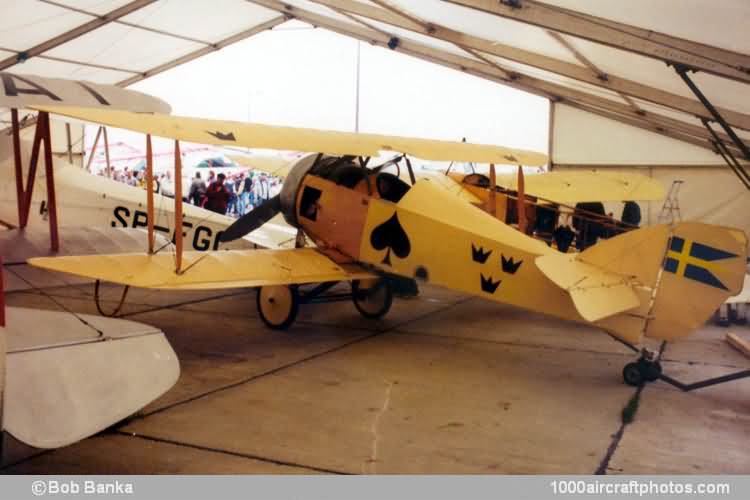The first of sixteen aircraft was first flown in June 1919, the last in 1922, and the type was soon nicknamed "Tummelisa" (sometimes abbreviated to "Lisa"), by the name of Little Tom's female counterpart. In 1926 the remaining eleven aircraft were transferred to the newly formed Flygvapnet (Air Force), and were designated Ö 1 (Övningsflygplan 1, practice aircraft) and assigned to F 3 at Malmen. Two aircraft were written off in 1926 before the type was transferred to F 5 at Ljungbyhed, also known as the Kungliga Krigsflygskolan (Royal Military Flight School).
The FVM was renamed CFM (Centrala Flygverkstaden i Malmslätt, Central Aviation Workshop in Malmslätt) in 1926, and produced another ten aircraft in 1928, while in 1933 three were assembled from spare parts. The last aircraft (s/n 3656 c/n 147, produced in 1928) was withdrawn from use in 1935, it was last flown in 1963 and is presently preserved at the Flygvapenmuseum (Air Force Museum) at Malmen. Although at least seven aircraft were lost, none of these accidents were fatal.
The Tummeliten was the first Swedish military aircraft that carried display markings. Two aircraft participated in an air show in Stockholm on January 19, 1921 and had their Army Aviation numbers on the fuselages replaced, 081 became Spader Äss (Ace of Spades) and 083 became Klöver Äss (Ace of Clubs). Later 085 became Ruter Äss (Ace of Diamonds) and two aircraft, 039 and 087 became Hjärter Äss (Ace of Hearts), and subsequently the display group Fyra Ess (Four Aces) was established.The symbols remained on the aircraft for a relative long period, at least for two to three years.
Mikael Carlson started building the pictured replica in 1982, it was registered SE-XIL in 1988, and powered by an original engine it was first flown in 1989. The aircraft has been entered in the Swedish Registry as CVM Ö 1 Tummelisa, however, CVM (Centrala Flygverkstaden i Malmslätt, Central Workshop in Malmslätt) was the successor to CFM in 1936, after the type was withdrawn from use, Ö 1 was introduced in 1926 while the aircraft carries markings from the early twenties, and "Tummelisa" was the nickname.
Thanks to Lars Henriksson and Lars Sundin for their input."
Span: 25 ft 7.1 in (7.80 m)
Length: 17 ft 11.4 in (5.47 m)
Height: 7 ft 8.1 in (2.34 m)
Weight empty: 860 lb (390 kg)
Loaded weight: 1,179 lb (535 kg)
Max speed: 92 mph (148 kmh)
Service ceiling: 16,404 ft (5,500 m)
